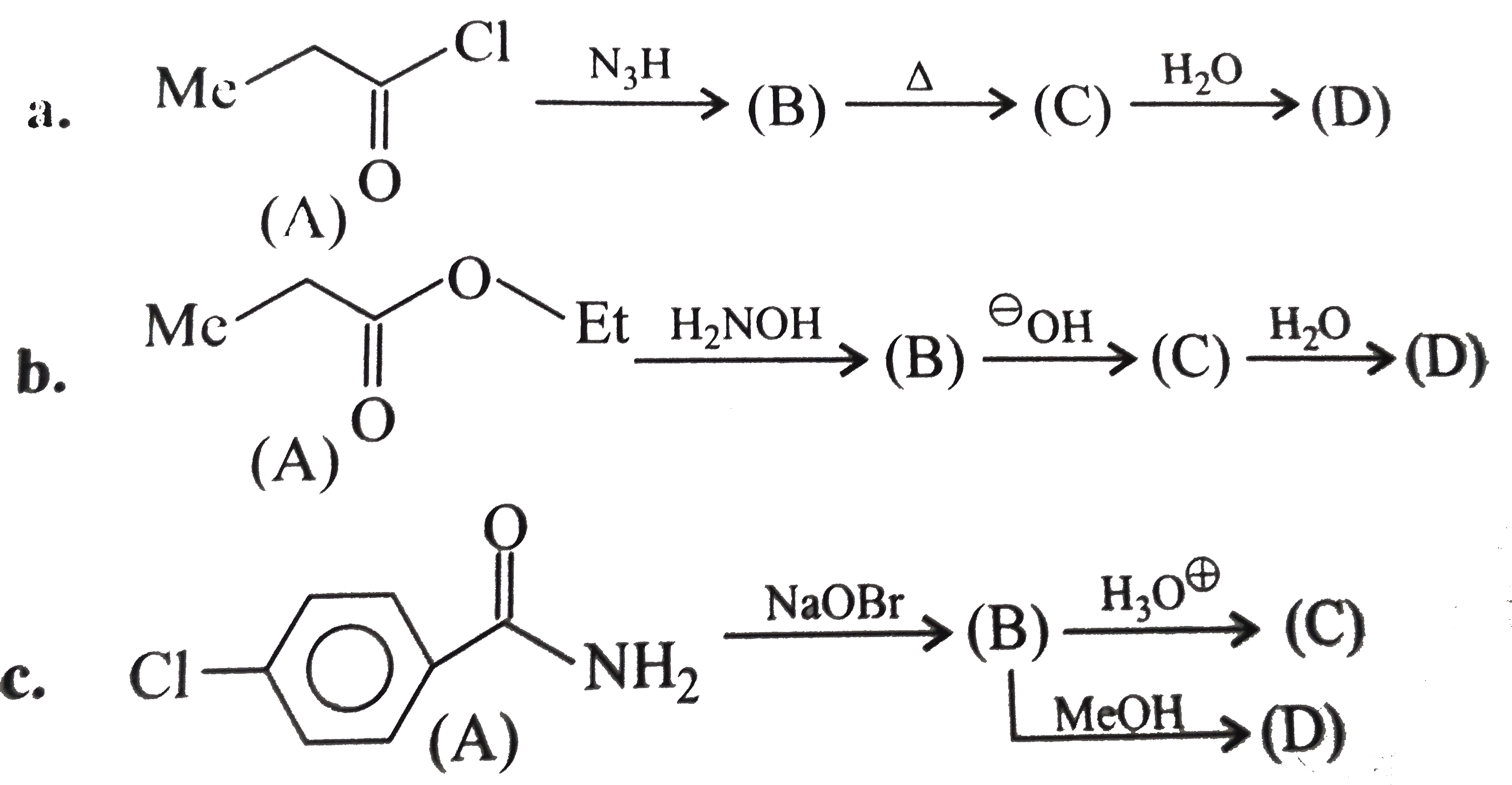Complete the following reactions:
a. 
b. 
c. 
d. 
e. 
f. 
g. 
a.
Under these reaction conditions, the CN is not hydrolysed to COOΘ.
b. 
c. 
d. 
e. 
f. 
g. First, H⊕ adds to (C=O) and not to (C=C), to give a resonance stabilised carbocation.

Topper's Solved these Questions
- ALIPHATIC AND AROMATIC ALDEHYDES AND KETONESBOOK - CENGAGE CHEMISTRY ENGLISHCHAPTER - ALIPHATIC AND AROMATIC ALDEHYDES AND KETONESEXERCISE - Solved Examples
13 Videos
- ALIPHATIC AND AROMATIC ALDEHYDES AND KETONESBOOK - CENGAGE CHEMISTRY ENGLISHCHAPTER - ALIPHATIC AND AROMATIC ALDEHYDES AND KETONESEXERCISE - Exercises Subjective
52 Videos
- ALCOHOL,PHENOL AND ETHERSBOOK - CENGAGE CHEMISTRY ENGLISHCHAPTER - ALCOHOL,PHENOL AND ETHERSEXERCISE - Archives Analytical And Descriptive
15 Videos
- APPENDIX INORGANIC VOLUME 2BOOK - CENGAGE CHEMISTRY ENGLISHCHAPTER - APPENDIX INORGANIC VOLUME 2EXERCISE - Short Answer Type
179 Videos
Similar Questions
Knowledge Check
See the following diagram and identify A,B,C,D,E,F and G
 AA-Afferent arteriole, B-Henle' s loop, C-Collecting duct, D-PCT, E-DCT, F-Pertibular capillaries, G- vasa rectaBA-afferent arteriole, B-Peritubular capillaries, C-Helne's loop, D-DCT, E-PCT, F-Collecting duct, G-vasa rectaCA-Afferent arteriole, B- PCT, C-Henle's loop, D-DCT, E-Peritublar capillaries, F-Collecting duct, G-vasa rectaDA-Afferent arteriole, B-Proximal convoluted tubule, C-Henle's loop, D-Distal convoluted tubule, E-Peritbular capillaries, F-Collecting duct, G-vasa recta
AA-Afferent arteriole, B-Henle' s loop, C-Collecting duct, D-PCT, E-DCT, F-Pertibular capillaries, G- vasa rectaBA-afferent arteriole, B-Peritubular capillaries, C-Helne's loop, D-DCT, E-PCT, F-Collecting duct, G-vasa rectaCA-Afferent arteriole, B- PCT, C-Henle's loop, D-DCT, E-Peritublar capillaries, F-Collecting duct, G-vasa rectaDA-Afferent arteriole, B-Proximal convoluted tubule, C-Henle's loop, D-Distal convoluted tubule, E-Peritbular capillaries, F-Collecting duct, G-vasa recta
If U={a,b,c,d,e,f,g,h}, find the complements of the following sets :(i) A={a,b,c} (ii) B={d,e,f,g] (iii) C={a,c,e,g} (iv) D={f,g,h,a)
View SolutionIf U={a,b,c,d,e,f,g,h}, find the complements of the following sets :(i) A={a,b,c} (ii) B={d,e,f,g] (iii) C={a,c,e,g} (iv) D={f,g,h,a)
View SolutionWhat should come next in the following letter series ?
H G F E D C B A G F E D C B A F E D C B A ?
1) E
2) G
3) F
4) B
5) None of these
View SolutionWhat should come next in the following letter series ?
H G F E D C B A H G F E D C B A H G F E D C B A H ?
1) G
2) E
3) A
4) I
5) None of these
View SolutionIf U = {a,b,c,d,e,f,g,h} , find the complement of the following sets:
A= {a,b,c} , B ={d,e,f,g} , C ={a,c,eg}, D = {f,g,h,a}.
View SolutionIf sinθ=12 then θ=
View SolutionIn Figure, CD and GH are respectively the medians of ABC and EFG . If ABC~FEG , prove that (i)ADC~FHG (ii)CDGH=ABFE (iii)CDB~GHE
View Solution













